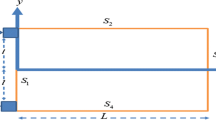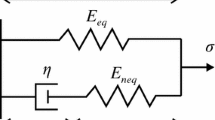Abstract
It is often declared in the literature that the seven classical invariants used to characterize the strain energy of a compressible orthotropic elastic solid are independent. In this paper, we show that only six of the seven classical invariants are independent, and a syzygy exists between the classical invariants. Consequently, all other sets of seven invariants, proposed in the literature, that are uniquely related to the set of classical invariants, have only six independent invariants.
Similar content being viewed by others
Explore related subjects
Discover the latest articles, news and stories from top researchers in related subjects.Avoid common mistakes on your manuscript.
1 Introduction
Following the work of Spencer [1], a strain energy function W e of a compressible elastic solid with two preferred orthogonal directions a and b can be expressed as
where C is the right Cauchy-Green deformation tensor and ⊗ denotes the dyadic product. W is an isotropic invariant C, a⊗a and b⊗b, i.e.,
for all proper orthogonal tensors Q. It follows that the strain energy function W e can be expressed as
where
and \(\operatorname{tr}\) denotes the trace of a second order tensor. These commonly used classical invariants were proposed by Spencer [1], but he did not mention in his paper [1], that the seven invariants are independent. However, in the past, several authors have declared that the seven invariants are independent (see for example references [2, 3]). In Sect. 2, we show that only six of the classical invariants are independent. In Sect. 3 we show that a syzygy exist between the classical invariants and between a set of invariants recently proposed by Shariff [4]. For various reasons, other sets of seven invariants (see for example reference [5]) have been proposed in the literature to characterize orthotropic elastic solids. Since the classical invariants can be expressed in terms of these sets of seven invariants, hence, only six of the seven invariants in these sets of seven invariants are independent.
2 Non-independent
For a compressible anisotropic elastic material with two non-perpendicular preferred directions a and b, the classical invariant set {I 1,I 2,I 3,I 4,I 5,I 6,I 7,I 8,I 9} is commonly used to characterize the strain energy function of an anisotropic elastic solid (see Spencer [1, 6]), where
and 2ϕ is the angle between the vectors a and b. The invariants I 1−9 are independent [6] with respect to the tensor C and, unit vectors a and b. If we consider the components of C, a and b relative to a fixed Cartesian coordinate system, then there are ten independent components (six from C and four from a and b) on the right hand-side of (4) and (5). For the set {I 1−9} to be independent the rank of the corresponding ten by nine “Jacobian” matrix should be nine. The set {I 1−9} is a minimal integrity basis [1, 6], hence all other polynomial invariants can be generated from this set. Since I 9 is fixed for an arbitrary deformation, the strain energy function is generally written in terms of the invariants I 1−8. When the directions of a and b are orthogonal, then cos(2ϕ)=0, and the strain energy can be characterized using only the seven invariants I 1−7. If, for arbitrary a and b, we choose the directions of the Cartesian X 1 and X 2 axes to be parallel to a and b, respectively, we then have, from (4)
where C ij are the Cartesian components of C. In this communication all subscripts i and j take the values 1, 2 and 3, unless stated otherwise. Since C has six independent components, there is a relation among the invariants I 1−7, which indicates that only six of the seven invariants are independent. We can also show that the seven invariants are not independent without resorting to the Cartesian components of C. We do this by writing C in the form
(λ i and e i are the principal value and the principal direction of the right stretch tensor U, respectively) and substitute (7) in (4) to obtain the expressions
where ζ i =(a•e i )2, ξ i =(b•e i )2,
The invariant set SH={λ 1,λ 2,λ 3,ζ 1,ζ 2,ξ 1,ξ 2} has been used by Shariff [4] to characterize the strain energy of an orthotropic elastic solid. However, there exists a relation between four of the invariants in the set SH, in particular the orthogonal relation,

taking note that,
In view of (10) and (11), only three of the invariants, say, ζ 1, ζ 2 and ξ 1 are independent. Hence, from (8), the seven classical invariants depend on six independent variables (invariants), which suggests that there exists a relationship among the seven invariants. In the next section, we show syzygies exist between the seven classical invariants and between the invariants proposed by Shariff [4].
3 Syzygy
Before we prove there is a syzygy between the seven classical invariants, we review a few preliminary concepts given in [6] to facilitate our analysis. In reference [6, p. 246] Spencer stated that:
-
1.
A polynomial invariant is said to be reducible if it can expressed as a polynomial in other invariants; otherwise, it is said to be irreducible.
-
2.
A set of polynomial invariants which has the property that any polynomial invariant can be expressed as a polynomial in members of the given set is called an integrity basis.
-
3.
An integrity basis is minimal if contains the smallest possible number of members. Clearly, all members of a minimal integrity basis are irreducible.
-
4.
It frequently happens that polynomial relations exist between invariants which do not permit any one invariant to be expressed as a polynomial in the remainder. Such relations are called syzygies.
Consider the right-handed set of vectors {a,b,n}. Note that
Hence
For simplicity of notations, we let I ab =a•Cb, I an =a•Cn, I bn =b•Cn, I n =n•Cn and I nn =n•C 2 n. From (13), we have
Similarly, it can be easily shown that
and
From the relation
we have
From the above equations, we have
From the relation
we get
Substituting equation (19) into (21) we have the relation
We note that relation (22) was also obtained by Merodio & Ogden [3]. Holzapfel & Ogden [2] showed that
We then have
In view of (14), (15), (18) and (22), it is clear that (24) shows a syzygy between the classical invariants I 1−7.
In view of (8), we can easily show from (24) that a syzygy exists between the invariants λ 1,λ 2,λ 3,ζ 1,ζ 2,ξ 1 and ξ 2. If we let λ 1=λ 2=λ 3=1 a syzygy exist between the invariants ζ 1,ζ 2,ξ 1 and ξ 2. Alternatively, we can also show that a syzygy exists among the invariants ζ 1,ζ 2,ξ 1 and ξ 2 from (10), where we have
Hence, we have
which shows a syzygy between the invariants ζ 1,ζ 2,ξ 1 and ξ 2.
References
Spencer, A.J.M.: Constitutive theory for strongly anisotropic solids. In: Spencer, A.J.M. (ed.) Continuum Theory of the Mechanics of Fiber Reinforced Composites. CISM Courses and Lectures, vol. 282, pp. 1–32. Springer, Wien (1984)
Holzapfel, G.A., Ogden, R.W.: Constitutive modeling of passive myocardium: a structurally based framework of material characterization. Philos. Trans. R. Soc. A 367, 3445–3475 (2009)
Merodio, J., Ogden, R.W.: The influence of the invariant I8 on the stress-deformation and ellipticity characteristics of doubly fiber-reinforced non-linearly elastic solids. Int. J. Non-Linear Mech. 41, 556–563 (2006)
Shariff, M.H.B.M.: Physical invariants for nonlinear orthotropic solids. Int. J. Solids Struct. 48, 1906–1914 (2011)
Rubin, M.B., Jabareen, M.: Physically based invariants for nonlinear elastic orthotropic solids. J. Elast. 90, 1–18 (2008)
Spencer, A.J.M.: Theory of invariants. In: Eringen, A.C. (ed.) Continuum Physics I (Part III). Academic Press, New York (1971)
Author information
Authors and Affiliations
Corresponding author
Rights and permissions
About this article
Cite this article
Shariff, M.H.B.M. Nonlinear Orthotropic Elasticity: Only Six Invariants are Independent. J Elast 110, 237–241 (2013). https://doi.org/10.1007/s10659-012-9389-y
Received:
Published:
Issue Date:
DOI: https://doi.org/10.1007/s10659-012-9389-y




